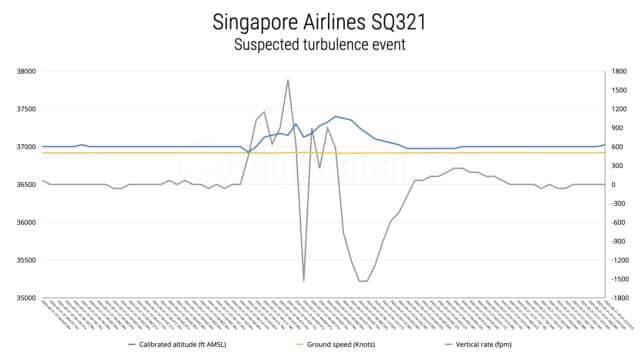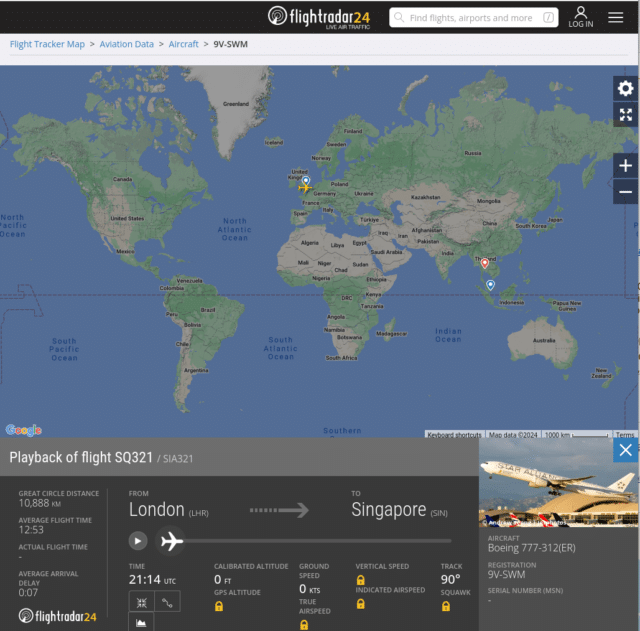Extreme Turbulence in Singapore Airlines flight 321
A few days ago (21st of May 2024), Singapore Airlines flight SQ321 encountered heavy turbulence on a passenger flight from London-Heathrow to Singapore.
There were 229 on board, including eighteen crew members. The flight had been uneventful until about ten hours into the flight. The aircraft was cruising at FL370 (37,000 feet) while breakfast was being served when passengers saw the seat belt sign light up.
Much has been made about the fact that many passengers were not wearing their seat belts. But with the breakfast service just beginning and passengers waking up ready for the final phase of the flight, it was a particularly vulnerable time. However, you really should keep your seat belt on while seated: a 2021 study by the NTSB found that only 21% of those seriously injured during turbulence were passengers and almost all of them had their seat belts unfastened. The report shows that the real risk is for the cabin crew.
Anyway, the seat belt light appeared. However, there wasn’t enough time for most people to react.
A few seconds later, at 07:49 UTC, “all hell broke loose” as passenger Andrew Davies said to CNN.
The plane just felt like it dropped. It probably only lasted a few seconds, but I remember vividly seeing shoes and iPads and iPhones and cushions and blankets and cutlery and plates and cups flying through the air and crashing to the ceiling.
Dzafran Azmir said something similar to Reuters.
Very suddenly there was a very dramatic drop so everyone seated and not wearing a seatbelt was launched immediately into the ceiling. Some people hit their heads on the baggage cabins overhead and dented it, they hit the places where lights and masks are and broke straight through it.
Amelia Lim told the Malay Mail that she suddenly found herself face down on the floor.
I was so afraid … I could see so many individuals on the floor, they were all bleeding. There was blood on the floor as well as on the people.
Traffic controllers and aviation enthusiasts saw the aircraft squawk 7700 about 200 nautical miles from Bangkok. Aircraft have a transponder on board, a piece of equipment that identifies the aircraft and specific details to radar installations. The pilots enter a four-digit code into the transponder, which might be assigned by air traffic control to identify that particular aircraft or might be a general code showing what type of flight it is. Changing those numbers to 7700 is the international code for an emergency and immediately makes it clear to everyone watching that there is a problem.
The aircraft diverted to Bangkok, where it landed safely at 08:45 UTC (15:45 local time). However, there was one fatality (since clarified as a heart attack) and 104 passengers with injuries that needed medical attention, including 30 with severe injuries.

You can follow the data from Flightradar24 by clicking through the image and pressing the play button at the bottom of the map.
Flightradar24 has also posted the granular ASD-B data, available in various formats including this graph which shows the turbulence event at 07:49 UTC.

However, be careful in how you parse this. Flightradar24 have commented that many analyses are including the descent from 37,000 to 31,000 feet as caused by the turbulence. In fact, the descent to 31,000 feet was flown by the flight crew as the start of the planned emergency descent to Bangkok. That is to say, the news reports that claim that the aircraft “plummeted 6,000 feet” are referring to the normal descent after the decision to divert was made.
This has brought clear air turbulence (CAT) back into the news, a high-altitude form of turbulence in clear skies, which means it cannot be detected through weather radar. Clear air turbulence is a rare but increasing weather phenomenon which is linked to climate change. Nature Magazine has an in-depth article on the subject from yesterday: Singapore Airlines turbulence: why climate change is making flights rougher
In a study published last year(1), Williams and his colleagues found large increases in clear-air turbulence between 1979 and 2020. Over the North Atlantic, severe clear-air turbulence — which is stronger than Earth’s gravity — became 55% more frequent. There were similar increases in turbulence all over the world, he says. The increase is almost certainly the result of climate change, which is strengthening the jet streams that cause turbulence, says Williams. “We already know it’s having an impact,” he says.
However, there’s a big IF here because at the moment we don’t know what caused the turbulence during the Singapore Airlines flight. In fact, there’s a lot of chatter on the aviation forums that the aircraft managed to fly into a thunderstorm.
For example, there is this comment from ywgflyer on Reddit:
They definitely flew through something, this wasn’t CAT, it was likely a cell that didn’t paint much.
The Honeywell RDR-4000 radar doesn’t do tilt settings, instead, it scans all tilts at once and displays weather as either “at your altitude”, or “below you” (crosshatched out on the display). At tropical latitudes the tops of the cells are all ice crystals and don’t paint much, I’ve seen a lot of cells that are clearly above FL400+ but are hatched out on the display. You go around everything even if it’s hatched out when flying near the ITCZ. Fly around with max gain so the weak returns actually show up.
Also have to wonder if maybe they inadvertently had the WX display opacity turned down? Kind of a gotcha in the 777, you can dim the radar display on the ND to the point that it may not be apparent there’s something painting. Most guys I know fly around with it on max brightness all the time and have that as part of their preflight flow.
And this one from vc10derness on PPRuNe
The ‘normal’ route for this aircraft after passing PTN is, as far as I can determine, is to follow P646 to POXEM and then M626 to DWI and onwards. There is no airway, that I can discover, that routes directly from PTN to DWI. If you follow that actual track the aircraft follows, however, it is very close to being a direct route between the two. My first speculation is… did the crew in the seats at the time request a direct route from Yangon to cut the corner and save time and fuel? At about 0803UTC the aircraft turns left by what appears to be about 40 degrees and the rapid exit from FL370 happens about 3 minutes later. Second speculation….I note from todays weather (about 24 hours later) that there is a sigmet for that area (south of the airway P646) of imbedded Cb to FL540. I can’t find the sigmet for the time of flight. Third, and final, speculation…the aircarft ‘local’ time was about1500. Imbedded Cb would suggest possible high cloud cover as well. All down to the weather radar and fight crew experience….SIA have the latter in spades and a very healthy respect for their aircraft weather radar systems’ health given their local weather. I await further professional information with interest. Stay safe folks.
Now, no commercial pilot will intentionally fly a passenger plane into a thunderstorm. The World Meteorological Society spells out the hazards.
Individually and collectively [thunderstorms] pose a major hazard to aviation operations on the ground and in the air due to the likelihood of:
severe turbulence, severe icing, microbursts, generating squalls or gust fronts giving severe low-level turbulence, lightning, high liquid water content, e.g. rain water content, and/or hail.
The violent updrafts and downdrafts in a thunderstorm can toss a full-sized airliner around like a toy.
That bit of the route is apparently known as “thunderstorm alley” and what the posts above are thinking is that the flight managed to fly straight into one. They are referring to overshooting tops, an above-anvil dome which appears at high level over severe storms. These have severe up- and down-drafts but may not show as clearly on the weather radar system because as Honeywell put it, ice is less reflective than rain. A study from UCLA explores this in more detail.
“[…] using radar to determine where frozen precipitation exists is usually somewhat difficult. Earlier we discussed that radar reflectivity was typically about 7 dBZ lower for a sphere of ice than a sphere of water due to ice scattering less energy than water.”
So the theory is that the flight crew asked for a more direct route which they believed to be clear, possibly with the thunderstorm activity showing as below them. If they didn’t realise the risk, they could easily have ended up flying into the overshooting top of the storm.
Simon Proud has posted to x.com (Twitter) overlaying the Singapore Airlines flight path onto images from the Japanese weather satellite. He believes that the aircraft flew very close to the updraft of a rapidly developing storm cell. Twitter’s video embed is being very weird today so please click on the photo to see Proud’s results.
Obviously, this is still very much conjecture; we will need to wait for more information as the investigation progresses. However, a thunderstorm strikes me as more likely than clear air turbulence, in which case the big question will be whether the weather radar system was operating as it should have been.
The majority of the passengers were flown to their destination of Singapore the following day. However, over twenty people are still in intensive care with spinal, brain and skull injuries.
Today Singapore Airlines updated the status of the remaining passengers and crew in Bangkok:
As of 1930hrs (Singapore Time) on 24 May 2024, Singapore Airlines (SIA) can confirm that 61 passengers and two crew members who were on board SQ321 are still in Bangkok. This includes 44 passengers and two crew members who are in the hospital receiving medical treatment.
Singapore’s Transport Safety Investigation Bureau will be leading the investigation. The National Transportation Safety Board, representing the US as the state of manufacturer, has sent a representative and four technical advisors to support the investigation. With any luck, we will find out more in the preliminary report next month.










A very clear summary, congratulations.
There is no mention of thunderstorm activity in the news reports.
So CAT is the most likely explanation and yes, I agree that, considering the severity of the turbulence, which obviously falls in the rare category of “extreme”, climate change may well have been a factor.
I feel very sorry for the people who were injured, not to mention the poor man who had a heart attack and died.
To my dismay, on the TV news, a reporter told the public that the aircraft “fell into an air pocket”.
Colour blind journalists have already managed to convince the public that orange is black – otherwise how can they justify calling bright orange objects like the flight data recorder and cockpit voice recorder “black boxes”?
But I had hoped that nonsense like aircraft “falling into air pockets” had been debunked many years ago.
Air pockets – if true – would have been “areas with an absence of air” (vacuum) in the sky.
“There is no mention of thunderstorm activity in the news reports.”
So?
Sylvia pointed to the first thing that puzzled me about the news reports: that they all talked about the plane “dropping” 6000 feet in 3 minutes as if that were something remarkable, which it wasn’t. (With the current emphasis on staying high as long as possible for fuel economy, I suspect this is a common descent speed outside of an emergency.) The news might well have also missed salient details that weren’t handed to them on a platter; we’ll have to wait and see what else comes out, if any observers were actually looking at the time/place the plane hit that downdraft.
BTW, wrt color mislabeling: ISTR you flew for DEC for a while. If so, a number of your passengers may have had DECtapes secured with LBT’s (“little blue thingies”), a term that continued even when the supplier changed and the LBT’s were red. (A lot of people in one of my social circles worked for DEC; I heard a lot of interesting stories….)
The BBC reports early information from the Transportation Safety Investigation Board:
https://www.bbc.com/news/articles/c9xx5pj095jo
Interesting points:
* The plane fell 178 feet in 4.6 seconds. (This is still less than freefall, which would have been 359 feet; for people to actually been thrown into the ceiling instead of just being light in their seats as in a roller coaster, there would have had to be a shorter period with a more-abrupt drop.)
* ‘the flight operated as normal until it probably flew over an area of “developing convective activity” ‘. This sounds like a proto-thunderstorm (possibly proto enough that radar didn’t show it?) — convection is movement caused by differences in temperature, where CAT seems (from what I read) to be more associated with differences in wind speed between the jet stream and adjacent air — but we’ll need to see more to have any real idea what happened, and probably much more research before an instrument that can detect such shifts (however caused) is approved for aircraft (and the airlines persuaded to pay for it…).
It looks like the BBC page was updated; it now reads:
The 4.6s event apparently consisted of 0.6 seconds of “down” and 4 seconds of “up”, which was indeed short and abrupt enough to outperform gravity: